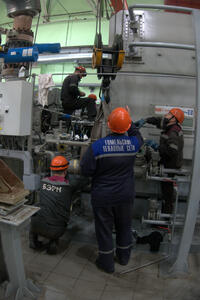LLC Russ-Turbo performs repair and maintenance of steam turbines auxiliary equipment with the supply of necessary spare parts:
- condensing unit
- oil systems and control systems
- steam distribution systems
- valve pressing
- steam turbines vacuum system
We carry out valves revision with the supply of necessary spare parts both at the customer’s site and at our site in St. Petersburg.
Steam turbine cylinders repair
The cylinder is the main part of the turbine, usually made from a complex and expensive alloy steel casting. The cylinder operates under conditions of high pressures and working steam temperatures. The reliability and safety of the operation of steam turbines depends on its condition.
The most common steam turbine cylinder failures
The main failures of cylinders are complex forms of warping in all directions, loosening of connectors, cracking, damage to fasteners, wear of the mounting ridges of clips and diaphragms, etc. For example, leakage may occur at the joints, fasteners malfunction, which will lead to a small steam leak. Over time, the problem will be aggravated, since through the fistulas, high-temperature water vapor, moving under high pressure through the gap that has arisen, contributes to intensive washing of the metal. Therefore, its impossible to accept malfunction, postponing repairs for later.
In this case, it is necessary to carry out metal surfacing using a special technology, then grinding and milling the damaged surface, metal to restore tightness. The cause of such problems is thermal shocks and the occurrence of residual internal stresses in the metal of the cylinder and fasteners. The more often the unit starts and stops, the faster they occur.
Ways of erosion prevention of the steam turbines flow path
To increase the service life of the blades and wear protection, we use several methods:
- Installation of moisture trapping equipment (stage-separators, in-channel separators, etc.) in the turbine flow path part.
- Increasing the size of the gaps between the rotor blades and nozzles, the size of which can be from 100 mm to 300 mm. Thanks to this measure, coarse droplets are crushed into smaller droplets, as well as the speed of moisture and steam particles is equalized.
- Reducing the moisture content of steam at the turbine outlet by increasing its temperature, reheating, and using separators.
- Elimination of binding wires, due to which the concentration of moisture is reduced.
- Arrangement of longitudinal grooves on the back of the blades located on the periphery. Such grooves contribute to the effective crushing of large drops by the blade itself, and also reduce the impact force.
- Soldering of protective pads on the blades made of cobalt alloy (stellite), which has high impact strength and wear resistance.
In addition, edge hardening and other protective coatings (for example, titanium-based alloys) can be used to strengthen the blades. Due to the application of the above measures, the erosion of steam turbines is significantly reduced, and the service life of the blades and the efficiency of the turbine plant are significantly increased.
Steam turbine diaphragm casing repair
The diaphragm is a very important part of the turbine, the condition of which directly affects the performance of the unit. It divides the inner surface into zones in which thermal energy is converted into mechanical energy. The diaphragm holder serves for the correct selection of steam entering the turbine. Faults and damage occurring in this area lead to a decrease in the efficiency of the unit and its failure, therefore, it is important to identify and eliminate them in time.
One of the damages is leak in the horizontal connector, which may be the result of a manufacturing defect, damage during repair, and also occur during operation. For example, sometimes cracks occur as a result of overheating of the unit, after ingress of scales that have an abrasive effect, and in other cases. The casing is deformed due to violation of the established modes of starting and stopping the turbine, after improper assembly of the unit or destruction of parts during the operation of the turbine.










